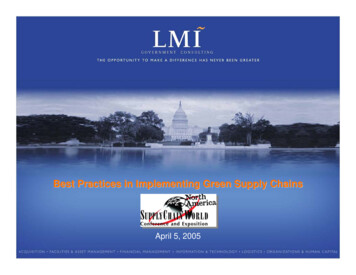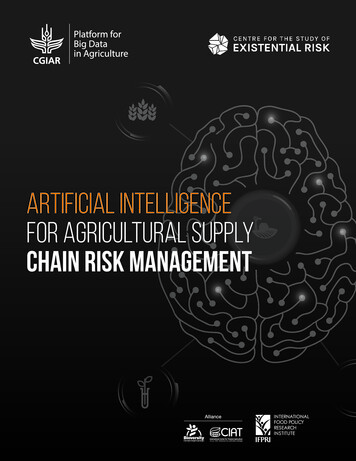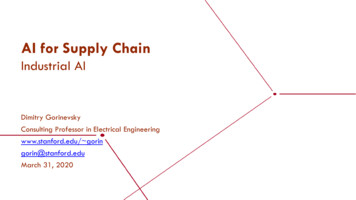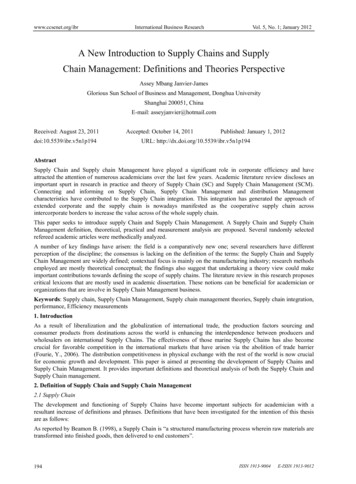
Transcription
Seven Principles of SupplyChain ManagementRecent events have shown just how fragile many supplychains are. Here’s how to apply seven principles of supplychain management to build in more resilience.By Mark WeimannMicrosoft Business ApplicationsSenior Technical SpecialistAugust 2020
Seven Principles of Supply Chain Management2ContentsIntroductionNot a chain, a pipeline4Amplifying the problem upstream6Beware the “bounce” effect8Supply chain principles and actionsPrinciple 1: Improve inventory visibility12Principle 2: Manage supplyand demand as a flow15Principle 3: Adopt a fast, flexiblepipeline planning system18Principle 4: Use real-time analytics tomeasure volatility of demand19Principle 5: Improve forecasting models21Principle 6: Diversify suppliers23Principle 7: Create new distributionnetworks and channels24Using technology to make thesupply chain more resilient26
Seven Principles of Supply Chain ManagementIntroductionThe COVID-19 pandemic has thrust the supply chain into the spotlight.Its fragility and how to make it more resilient have been widelydiscussed. The phrase “supply chain” has become a buzzword toexplain a complex process with many moving parts. But what can bedone practically to make it more robust? To answer this question, weneed to better understand the principles of the supply chain.But first, I would like to challenge conventional thinking of what asupply chain actually is. The term “supply chain management” canbe traced back to 1982 and has gained in popularity throughout the1990s. Since then, many books and theories have been written aboutit, and many people have taken on the title “Supply Chain Manager.”Recently, images of panic buying and supermarket shelves emptiedof toilet paper, rice and flour were seen in many countries. Suddenly,people who had never thought about the supply chain faced theprospect of shortages of staple products and panicked. This waspartly caused by a failure to understand the supply chain, but it alsohighlighted how vulnerable and susceptible it is to outside influence.If you think about a chain, what do you think of? I have spenta lot of my life sailing ocean going boats. So when I think of achain, I think of something that is incredibly strong and rigid,even unbreakable—something that, during storms, I have hadto trust my life to. It’s unthinkable that a chain would break,yet we use the word “chain” to describe what can happen toa system that we visualise as extremely vulnerable to forcesoutside our control.3
Seven Principles of Supply Chain Management4Not a chain, a pipelineI prefer to think of the supply chain as a “supply pipeline.” While it doesn’troll so eloquently off the tongue, if you think about a pipeline, whatcomes to mind? A pipeline transports liquid, but it sometimes developsleaks or gets blocked. It can also run dry if supply doesn’t match thepipeline “flow” or demand. Does that sound more like what we recentlyexperienced as a result of panic buying? For all sorts of reasons, peopletook to buying more of some products than usual.This very short, intense spike in demand drained stock from the shelvesand back rooms of stores and supermarkets. In Australia, four majorsupermarket chains account for more than 3,700 stores between them,and they all had their shelves stripped of some products at some point, ifnot simultaneously, during the first months of the COVID-19 pandemic.Figure 1. Major supermarket chains and number of stores in : Corporate websitesBack to top Not a chain, a pipeline
Seven Principles of Supply Chain Management5Panic buying was so intense that March retail sales set a newrecord, rising a seasonally adjusted 8.5 per cent, according tothe Australian Bureau of Statistics (ABS). In particular, turnoverdoubled for toilet paper, rice, pasta and flour.The reality is that the supermarket chains have tuned theirreplenishment algorithms so that they only replenish stockat each store’s consumption rate. So when panic buyingsimultaneously depleted stocks at all stores, the distributioncentres (warehouses) that receive, store and replenish from bulksuppliers were also emptied.Remember our supply pipeline. Now, imagine a large pond fillinga small pond. If you don’t refill the large pond, both the largeand the small pond will run dry, which metaphorically is whathappened. Only a few manufacturers make each product, butthey supply all the grocery chains. This magnified the effect ofpanic buying—which emptied the pipeline.Back to top Not a chain, a pipeline
Seven Principles of Supply Chain Management6Amplifying theproblem upstreamManufacturers make and supply goods usingsupermarkets’ forecasts, which are based on theconsumption rates in their stores.So the manufacturers only buy raw materials to supply this rate. Thismeant that when supermarkets asked the manufacturers to turn onthe taps harder, they did not have the raw materials needed to meetthe unexpected demand. For example, manufacturers of hand sanitiserexperienced severe shortages of raw ingredients and packaging.The shortages quickly moved upstream as manufacturers requestedmore raw materials. The raw material suppliers weren’t expecting toproduce more than the normal rate of supply and ran out. When youcouple this with the distance the (mostly foreign) manufacturers arefrom the distribution centres, and how far they are from the stores, theproblems multiplied again. The so-called supply chain was broken—or,as I prefer to think of it, the supply pipeline and all the reservoirs andpipes that fed it, were drained. Furthermore, the problem became morepronounced upstream. This effect was first documented by Americancomputer engineer and systems scientist Jay Forrester in 1961 and calledthe Forrester effect or the Bullwhip effect. It is likened to cracking awhip. A small hand movement is increasingly amplified the further awayyou move from the hand.Back to top Amplifying the problem upstream
Seven Principles of Supply Chain Management7In the same way, the effect of a small fluctuation in demandat a store increases the further it moves from the store to themanufacturer and beyond. Think of it like this: a store sells 300mldrink cans that its distribution centre supplies in cases. But thedistribution centre has to order the cans from the manufacturer inpallets, so the order multiplier effect causes a Bullwhip increase indemand the further it moves up the supply pipeline.Figure 2. The Bullwhip effectSupplierManufacturerCustomer demandAmplifying the problem upstreamWholesalerSupplierBack to top CustomerRetailer
Seven Principles of Supply Chain Management8Beware the “bounce” effectIf you think this is where the pipeline problemends, think again. Take the shortages caused bythe recent panic buying: how did we get productsback on the shelves?Supermarkets needed to order complete refills of somemerchandise, but they also had to refill their distributioncentres. In turn, the manufacturers had to produce more,which required more raw materials. All these steps were wayabove normal consumption levels.But the average person has not suddenly begun to consumemore. The pipeline contents are simply stored in people’scupboards and garages, and they won’t need to buy anyof these items until they consume what they have. Sosupermarket stock stays on shelves, the distribution centresstay full, and the manufacturers have to stop producing—theopposite of what happened previously. The pipeline is full andthe taps are effectively shut, so the supermarkets cut back onorders, causing the supply pipeline to “bounce”.Back to top Beware the “bounce” effect
Seven Principles of Supply Chain Management9This effect was graphically illustrated in April when Australianretail sales plummeted 17.7 per cent after the March spike,according to the ABS. So with all this in mind, how do weaddress this problem and ensure we are better able to handlean abnormal spike in demand? Bear in mind that in modernhistory, there has never been such an intense peak of demand.We have to look to World War I, World War II and the Spanishflu pandemic to find examples. The most obvious answer is tohold more stock, but that is not a solution. Holding more stockrequires more space, consumes liquidity and often leads towaste through expiry of short life cycle products.So to understand what we can do to adapt the supply pipelineto these intense peaks in demand, we need to consider anumber of principles of supply and demand. They haven’tchanged in more than 250 years and likely never will; however,when looking for silver bullets—instantaneous mysticalsolutions to problems—we often overlook the obvious.Back to top Beware the “bounce” effect
Seven Principles of Supply Chain Management10At Breville we focus on a concept aroundAgility. We build our information systemsso that our executives have accurate dataon what’s happening up and down oursupply chain. That gives us the abilityto pivot the business depending onwhat’s happening at the consumer ormanufacturer end.”Nathan O’DonnellDynamics 365 Global Program LeaderBrevilleBack to top Beware the “bounce” effect
Seven Principles of Supply Chain Management11Supply chain principles and actionsThe solutions lie in the seven principles of effective and efficientsupply chain management.Improveinventory visibility1Diversify suppliers276SevenPrinciples5Improveforecasting modelsSupply chain principles and actionsManage supply anddemand as a flow3Adopt a fast,flexible pipelineplanning system4Use real-time analytics tomeasure volatility of demandBack to top Create new distributionnetworks and channels
Principle 1:Seven Principles of Supply Chain Management12Improveinventory visibilityThe first and most important consideration is havingvisibility of inventory. As futurist and author JohnNaisbitt said, “The most reliable way to forecast thefuture is to try to understand the present.”If we don’t have integrated, real-time visibility of inventorythroughout the supply chain, we risk losing control. Yet betweenprocurement and sale, too many organisations have “blind spots”,where they have leaks and delays in gaining visibility of stock,creating real challenges.Take the case of a high fashion retailer I worked with. It had greatsystems for new product development and sales, but tracked itssupply chain on spreadsheets. In some cases, it had a 12-week leadtime from order to delivery of items that were highly fashionable,making it vulnerable to volatility in demand. Additionally, no one hadany idea of what was available where or when. This meant it couldn’tcommit to fulfilling customer orders and so, in the fast moving worldof high fashion, it couldn’t compete. As a result, sales and marketshare slipped. In industry terms, it fell behind the fashion curve, whichled to its demise and acquisition by another brand.Back to top Principle 1: Improve inventory visibility
Seven Principles of Supply Chain Management13By contrast, Perth-based Marubeni-Itochu Tubulars Oceaniahas shifted its finance and operations system to the cloudto gain end-to-end transparency of its oil and gas tubingsupplies. Employees now have access to real-time inventorymovements and balances, enabling them to provide a muchimproved experience for customers.ActionMake sure systems are in place that enable real-time visibilityof inventory across your distribution network—from supplier tocustomer—and that all staff know how to transfer informationacross corporate borders, with visibility and velocity. Also ensureyour staff understand the importance of having an accurateinventory. It must be updated as a priority for each transaction,and losses or gains accounted for and processed immediately.Back to top Principle 1: Improve inventory visibility
Seven Principles of Supply Chain Management14For us, the consumer is at the centreof everything we do. We look atresiliency and agility in terms of anoutcome—we want our customersto be able to buy our products whenand where they want to.”Nathan O’DonnellDynamics 365 Global Program LeaderBrevilleBack to top Principle 1: Improve inventory visibility
Principle 2:Seven Principles of Supply Chain Management15Manage supply anddemand as a flowSupply cannot just switch on and off—and the morevolatile the demand, the less we are able to sourcesupply. So we need to manage the product flowthroughout the supply pipeline.This means that in an ideal state, there is a balanced movement ofproduct from supplier through to customer. The store holds theamount of product being consumed. It matches the amount in thepipelines from the distribution centre to the store, and from thesupplier to the distributor, and so on back through to raw materials.This theory is perfectly illustrated by Dr Eli Goldratt, the businessmanagement guru in his best-selling novel The Goal, where heshows that it is vital to balance flow, not capacity.Auckland-based homewares retailer Citta, for example, is usingbusiness intelligence to perfect its flow of products from its supplychain, ensuring it has enough to satisfy demand, but not so muchthat it’s left with unsold stock at the end of a season.Back to top Principle 2: Manage supply and demand as a flow
Seven Principles of Supply Chain Management16ActionAim for more frequent, smaller deliveries when trying tomanage the way products are procured and delivered. Thisis better than infrequent, large bulk deliveries, and balancesthe flow of movement through the entire supply chain. Weneed to rethink the concepts of minimum order quantitiesto remove lumpy irregular supply. This will mean the needto have a new conversation with suppliers and, potentially,logistics providers. Because of the cost of freight, retailersoften increase quantities to reduce the freight cost per unit,but for products with volatile demand (see Principle 4), thisincreases supply issues if demand changes.Back to top Principle 2: Manage supply and demand as a flow
Seven Principles of Supply Chain Management17Using Power Apps, we wereable to deliver a standardisedworkflow and approval processto create efficiencies in oursupply chain.”John KhouryChief Information OfficerAllied PinnacleBack to top Principle 2: Manage supply and demand as a flow
Principle 3:Seven Principles of Supply Chain Management18Adopt a fast, flexiblepipeline planning systemThe supply chain reaction time spans the period frommanufacturing to when a customer purchases a product. Itis almost self-evident that the longer it takes for the supplysignal (abnormal sales volume) to reach participants in thesupply pipeline, the greater the risk of the pipeline beingemptied before it produces a “refill signal.”At a large textile company, for example, their systems would onlyallow a full regenerative plan over the weekend, such was the computetime needed—and then it would need another 2–3 days of analysis.As a result, a major shift in demand could take up to 10 days beforeupstream changes came into effect.ActionEnsure the supply chain planning system can run at any time.Legacy systems create delays in signal processing. This is oftendue to planning processes running overnight or only at weekendsbecause of the length of time they take, and the impact on thesystem due to downtime. Having a system that can run in minutesand at any time eliminates delays and maximises the ability toidentify supply chain issues and quickly resolve them.Back to top Principle 3: Adopt a fast, flexible pipeline planning system
Principle 4:Seven Principles of Supply Chain Management19Use real-time analytics tomeasure volatility of demandNot all products are consumed at the same rate or time;some are consumed at a flat rate. Take the flour exampleagain. The average person’s rate of consumption hasn’tchanged during the pandemic.At various times in their life, a person may use consume more,but consumption is largely predictable. Compare this with fashionclothing, which is highly volatile. It’s based on trends, styles,influencers and celebrities, and demand can fluctuate wildly fromstore to store, region to region, and culture to culture.ActionInstall real-time analytics across the entire supply pipeline. Thisis a fundamental requirement to manage demand and supply.Identify and group products by their volatility, and use highvisibility analytics to monitor and provide real-time alerts totightly manage volatile stock levels. For products with highlyvolatile demand, tie demand very tightly to supply signals, andautomate alerts for when these move outside tolerance. Fornon-volatile products, take a more relaxed approach with setminimums and maximums, and reordering points for restocking.Back to top Principle 4: Use real-time analytics to measure volatility of demand
Seven Principles of Supply Chain Management20The challenge of COVID-19 brokedown the localised site based silos fortwo reasons. We had to move outsideof traditional site based productionlines and the use of our S&Op systemsplanning and BI Reporting togetherare now embedded to ensure effectivebusiness enablement throughtechnology and systems.”John KhouryChief Information OfficerAllied PinnacleBack to top Principle 4: Use real-time analytics to measure volatility of demand
Seven Principles of Supply Chain Management21Principle 5:Improve forecasting modelsA lot of people are scratching their heads about why theirforecasts (or other people’s forecasts) let them down duringCOVID-19. The truth is that we have not had this level ofdemand fluctuation during the career of anyone working in asupply role in 2020.To find this, we have to go back to 1914–18 (World War I), 1939–45 (WorldWar II) or 1918 (the Spanish Flu). However, most retail and distributionorganisations across the globe today use forecast models that only look attwo to three years of historical data.So, regardless of the level of data science applied to those models, theycould not have forecast the effect of COVID-19. Customers strippedsupermarket shelves for one of two reasons: fear that stores would closeand people would not be able to buy essentials; or greed, which led somepeople to bulk buy to resell at much higher prices for a profit.Queensland-based snack foods company Majans, for example, has digitisedits supply chain to dramatically reduce the time of every process. It’s alsousing Internet of Things technology to help identify trends early. Thisenables line, plant and executive management to make more informeddecisions, optimise operations and rein in costs and risk.Back to top Principle 5: Improve forecasting models
Seven Principles of Supply Chain Management22When developing these systems, businesses also need to crosscorporate boundaries to share forecasts with suppliers andcollaborate in real time. Having a single shared model, where allparticipants cooperate to identify peaks and valleys, and determinewhether they are one-off or sustained events, would assist withdeveloping remediation strategies.Toyota has been doing this for years, not just with forecasts but alsowith visual Kanban views of its supply chains. Its systems aretightly integrated with its suppliers—so much so that if a Toyotaproduction line stops, the relevant suppliers’ production lines arestopped as well.ActionIncrease the amount of available data so that we canaccurately forecast extraordinary events, such as whathappened with the pandemic. Do this by looking at currentforecast models and how they connect with your planningsystems, and develop signals to identify un-forecasteddemand in real time. We also need to create procurementmethods that have very short-term reaction times.Back to top Principle 5: Improve forecasting models
Seven Principles of Supply Chain Management23Principle 6:Diversify suppliersOne of the factors that has exacerbated the shortagesduring COVID-19 is that for certain products we havevery few suppliers, and they supply many distributorsand retailers. This means that when the volume requiredto resupply entire supermarket chains and distributioncentres, it has a massive impact on manufacturers.The suppliers simply couldn’t catch up with demand in a short space oftime, bearing in mind that they had to restock entire stores and keepup with normal consumption.ActionDiversify supply. This means spreading the risk across multiplesuppliers, both local and overseas. We have all heard a lot about howmanufacturing has all moved offshore, based on price. Unfortunately,the downside is that in many cases we have come to rely on overseassupply, often resulting in long lead times and increased risk. However,to balance the flow, it is essential to have suppliers with short and longlead times, and even different cost models.Back to top Principle 6: Diversify suppliers
Principle 7:Seven Principles of Supply Chain Management24Create new distributionnetworks & channelsIn modern society, we take as a given many things thatcan be changed. We may have been used to the idea ofa supermarket being the most convenient way to buygroceries and other convenience items, but technologyand logistics have made it possible to use other channels.The COVID-19 crisis has forced many people who may not haveconsidered purchasing online to do so. In fact, during the pandemic,online shopping proved very popular and at a stage, grocery retailerswere forced to pause due to lack of supply. For example, Uberand Uber Eats have changed our way of thinking about personaltransport options and consuming restaurant food. We can imagine anew future, not only for grocery and convenience shopping, but alsofor many other everyday items.Back to top Principle 7: Create new distribution networks & channels
Seven Principles of Supply Chain Management25ActionTransport and logisticsWe could use an Uber-style service to deliver click-and-collect orders.Such a service would broaden the availability of local delivery networks,particularly for the frail, the elderly and the vulnerable. This service couldapply to any products that are easy to transport, such as groceries andperishables, where timeliness is critical to the product’s quality and lifecycle.Social shoppingThe old concept of the Tupperware party could be used for productsthat fall outside the groceries and convenience items category. For thosewho haven’t been around long enough, party selling was a big trend inthe 1970s and 1980s. The only way to achieve scale in selling was to masssell—in people’s homes.Tupperware was an “in” product that was sold in homes. A host wouldinvite their friends to a social occasion that happened to centre aroundsomeone selling a highly desirable product. Now, in the context of socialmedia, imagine using a Teams meeting to invite your friends to a callwhere a product seller could demonstrate, discuss, answer questions,enable promotional pricing and even take orders, which could bedelivered to your home. This could suit sectors such as cosmetics, fashionand technical products where product knowledge is an important factorin the buying decision.Drive-through collectionImagine being able to order online, drive to a store or a warehouse, andhave your order loaded into your boot, without you even getting out. Wehave drive-through fast food outlets and bottle shops, and a small numberof home and office goods retailers offer a drive-through service, so whynot expand the concept to cover groceries, fresh food or other items?Back to top Principle 7: Create new distribution networks & channels
Seven Principles of Supply Chain Management26Using technology to make thesupply chain more resilientJust as a chain is important for keeping a boat safe in a storm,following the principles of a resilient supply chain is essentialfor managing the highly complex processes that ensurecontinuous supply.While the COVID-19 crisis has shone a spotlight on the supply chain,when we break it down into the principles, and follow them, it helps usto focus on how to make it more resilient.Ensuring resilience doesn’t necessarily mean throwing out all oursystems and starting anew. It can mean re-evaluating existing systemsto ensure they are optimised for resilience. It can also mean addingnew or additional workloads to existing systems and infrastructure, andcapability, or expanding the footprint of business applications.The ability to deploy modern business applications as individualworkloads, or as a whole, brings a different model of agility that enablesrapid prototyping and constant innovation.Integration is one of the big challenges with modern systems. This iswhere enterprise resource planning (ERP) systems assist businesses.They were developed to provide fully integrated transactions acrossorganisations, not just in the supply chain, creating the right level of datavisibility for different stakeholders.
Seven Principles of Supply Chain ManagementThis visibility and agility can often make up for a lack of features. Forexample, knowing how much of a product is available at any locationin real time far outweighs not having fields to describe detailedproduct commentary.Furthermore, the arrival of cloud-based ERP systems brings a level ofagility and scalability never seen before. They also offer a new, moreaffordable way of adopting advanced technologies, such as analyticsand artificial intelligence (AI).If the current crisis has taught us anything, it’s that business systems mustoffer the visibility and agility to enable organisations to become moreresilient and adaptable to sudden change. But they also need to supportgood business fundamentals—such as the supply chain principles.Microsoft Dynamics 365Microsoft Dynamics 365 supports these principles with an integratedSupply Chain Management suite. Through the Microsoft PowerPlatform, Dynamics 365 offers the ability to rapidly innovate, using “lastmile of delivery” low code, automation and AI technologies. Dynamics365 also comes with prebuilt business accelerators for automotive,health and other industries. Further, these technologies are all deliveredsecurely and with scalability on the Azure cloud platform.Get started with a guided tour 2021 Microsoft Corporation. All rights reserved. This document is provided “as-is.” Information and viewsexpressed in this document, including URL and other Internet website references, may change withoutnotice. You bear the risk of using it. This document does not provide you with any legal rights to anyintellectual property in any Microsoft product. You may copy and use this document for your internal,reference purposes.27
supply chain more resilient Principle 6: Diversify suppliers Beware the "bounce" effect. 4. 6. 12. 18. 15. 19. 21. 24. 26. 23. 8. Introduction. Supply chain principles and actions. . Seven Principles of Supply Chain Management 5 Not a chain, a pipeline Panic buying was so intense that March retail sales set a new record, rising a .










